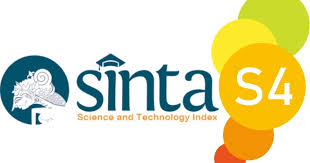PENINGKATAN HASIL BELAJAR MATEMATIKA DALAM MENYELESAIKAN SOAL FAKTA DASAR PERKALIAN DENGAN MATHEMATICAL OF FINGERING SYSTEM PADA SISWA KELAS II SD NEGERI 01 PADANG LAWEH
Abstract
One way to improve human quality is to learn, especially by studying mathematics, because mathematics is very necessary in everyday life, for example in terms of buying and selling, accounts payable, making a product. In conclusion, mathematics plays an important role because humans cannot be separated from problems, while those problems need to be solved. To solve these problems, critical thinking is needed. From the Basic Competence of "doing multiplication of numbers which results in a two-digit number" in class II, teachers often have difficulty instilling the concept of multiplication, especially the basic facts of multiplication, namely the multiplication of two one-digit numbers. This research was carried out at SD Negeri 01 Padang Laweh, with the research subjects of class II students in the 2021/2022 academic year as many as 26 students, 14 female students and 12 male students. Based on the results of classroom action research that has been carried out in class II SD N 01 Padang Laweh in 2021/2022 Dharmasraya, the following conclusions can be drawn: Student learning outcomes in the material do multiplication which results in two-digit numbers increasing with the fingering system. This can be seen from the results of the first cycle of the test, the average value of the first meeting is 70, the second meeting the average value is 80.38, the third meeting the average value is 86.15, the post test score is 91.15.
Downloads
References
Anni, Tri. 2004. Psikologi Belajar. Semarang. UNNES PRESS.
Arikunto, Suharsini, Suhardjono dan Supardi. 2007. Penelitian Tindakan Kelas. Jakarta: Bumi Aksara.
Depdikbud. 1994. Kurikulum Pendidikan Dasar dan Menengah: Garis-GarisBesar Program Pengajaran. Jakarta: Depdikbud.
Dimyati, dkk. 2002. Belajar dan Pengajaran. Jakarta: Asdi Mahasetya.
Drost. 1998. Sekolah: Mengajar atau Mendidik ?. Yogyakarta: Kanisius.
Hudojo, Herman 1988. Mengajar Belajar Matematika. Jakarta: Dikti-Depdikbud.
Khotimah, Khusnul. 2009. Pembelajaran Berhitung dengan Menggunakan jarimatika untuk Meningkatkan Motivasi Belajar dan Kemampuan Berhitung Siswa MIM Candirejo Ngawen Klaten, (Online), http://digilib.uin-suka.ac.id/gdl-php?mod=browse&op=digilib.uinsuka-khusnulkho , diakses 10 September 2009).
Madya, Suwarsih. 1994. Pedoman Penelitian Tindakan Kelas (Penciptanya dalam Kemmis dan Taggart) Yogyakarta: IKIP Yogyakarta.
Marpaung, Y. 2000. Prospek RME untuk Pembelajaran Matematika diIndonesia : Makalah Seminar di UNY.
Mulyadi, dkk, 1994. Pegangan Matematika I untuk SLTP Kelas 1 Caturwulan1,2,3. Bandung: Armico.
Natawidjaja, Rachman. 1979. Alat Peraga dan Komunikasi Pendidikan. Jakarta:Gramedia.
Negoro, ST,. Harahap, B. 1987. Ensiklopedi Matematika. Jakarta: Galia Indonesia.
Rahayu, Puji. 2008. Efektivitas Penerapan Jari matika Terhadap Anak SD(Online),http://www.jawapos.co.id/metropolis/index.php?act:detail&nid, diakses 10 September 2009).
Andikos, F., & Gusteri, Y. (2016). Komunikasi Manusia Dengan Komputer. Bogor: In Media.
Copyright (c) 2022 Yeni Pujiarti, S.Pd

This work is licensed under a Creative Commons Attribution 4.0 International License.













